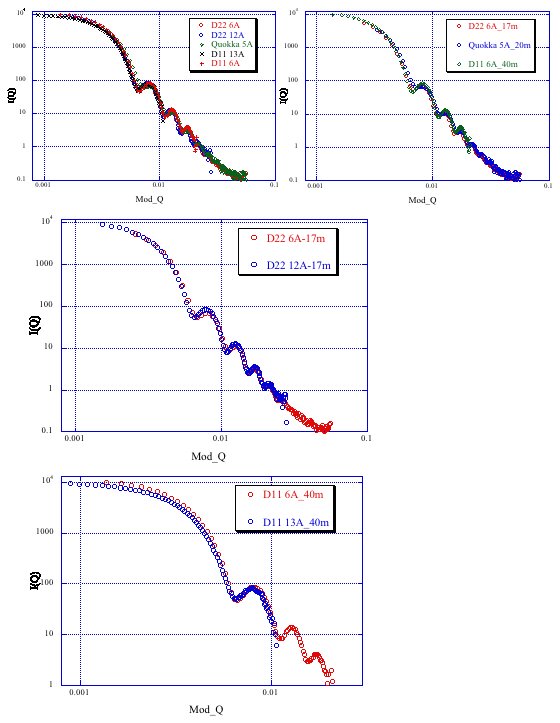Latex Round Robin
Samples
A polystyrene latex sample has been used for round robin measurements. As it is fairly monodisperse, it provides good tests for resolution. The hydrogenous polystyrene latex designated PS3 has been prepared in Uppsala (Materials Physics, Uppsala University) by Maja Hellsing.
Three samples at nominal concentrations of 0.4%, 0.1% and 0.025% designated A, B and C have been prepared in D2O with 1 mM added NaCl.
Measurements
At present (30 April 2012) the following instruments have been used for SANS measurements on the latex samples:
D22 at the ILL Grenoble, France
Data measured with a sample-detector distance of 17.6 m and an incident wavelength of 12 Angstrom and 6 Angstrom
Sample Run Number Wavelength A 50488 6 A B 50489 6 A C 50490 6 A Solvent 50491 6 A E. Cell 50487 6 A Block Beam 50492 6 A
Sample Run Number Wavelength A 50506 12 A B 50507 12 A C 50508 12 A Solvent 50509 12 A E. Cell 50505 12 A Block Beam 50510 12 A
D11 at the ILL Grenoble, France
Data measured with a sample-detector distance of 34 m and an incident wavelength of 13 Angstrom and 6 Angstrom Data measured with a sample-detector distance of 8 m and an incident wavelength of 6 Angstrom Data measured with a sample-detector distance of 1.2 m and an incident wavelength of 6 Angstrom
Quokka at ANSTO, Lucas Heights, Australia
Data measured with a sample-detector distance of 20 m and an incident wavelength of 5.08 Angstrom
SANS2D at ISIS, Didcot U.K.
A sample with nominal concentration 0.5% has been measured with a sample-detector distance of 12 m. (This instrument uses a polychromatic beam in time-of-flight mode.)
Data Format
Contributors are encouraged to deposit their data using the cansas1d/1.0 XML data standard for 1-D SAS data within a ZIP or gzip archive file. A WWW form (canSAS/xmlWriter) is available to translate three-column ASCII text data into the canSAS1d/1.0 XML format.
Summary Plot
- Summary Plot Sample A
